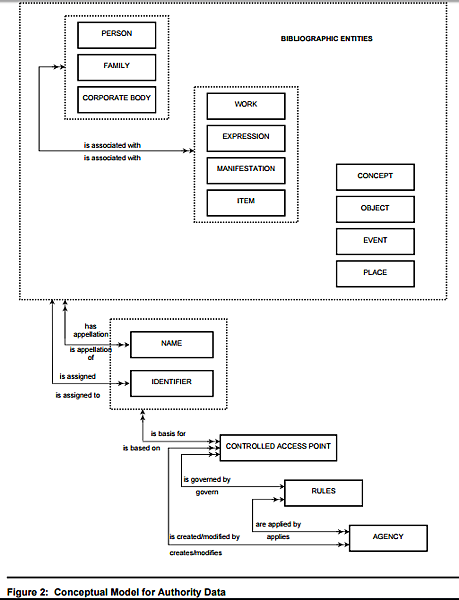上課內容:
權威控制
定義:
1. 是圖書資訊學中一個整理圖書館目錄和目錄資訊的方式,使同一主題使用相同、唯一的標題
2. 這些標題貫徹整個目錄庫並且能與其他交叉引用的資料庫協同工作
3. 每個標題簡明扼要地其應用範圍和用法,此組織形式方便了圖書館工作人員而且對研究者很友好
→ 同一主題,用相同標準
4. 權威控制是一個準備規範數據、權威資料的方法,再以這個方法得到一項權威紀錄
Ex:
1. 當以簡體的台進入輔仁大學會自動轉成繁體的「臺」,原因是輔仁大學的權威控制是以繁體為主
2. 姓名不是權威控制的一項結果,這時就以其他方式去區分身分,例如身分證
目的:
1. 在線上編目系統中,可利用系統自動聯結與指引功能,辨識個人作者或團體作者的匿名重複性與更替情形,同時將相關主題聚集在一起
2. 提供各個圖書館管理館藏與讀者檢索的便利,對於各館之間館藏交流或整合查詢也有重大影響,如果兩個合作館的權威控制系統不相同時,就會造成讀者檢索時無法檢索到所需的完整
益處:
1. Better researching. Authority control helps researchers get a handle on a specific subject with less wasted effort. A well-designed digital catalog/database enables a researcher to query a few words of an entry to bring up the already established term or phrase, thus improving accuracy and saving time.
2. Makes searching more predictable. It can be used in conjunction with keyword searching using "and" or "not" or "or" or other Boolean operators on a web browser. It increases chances that a given search will return relevant items.
3. Consistency of records.
4. Organization and structure of information.
5. Efficiency for cataloguers. The process of authority control is not only of great help to researchers searching for a particular subject to study, but it can help cataloguers organize information as well. Cataloguers can use authority records when trying to categorize new items, since they can see which records have already been catalogued and can therefore avoid unnecessary work.
6. Maximises library resources.
7. Easier to maintain the catalog. It enables cataloguers to detect and correct errors. In some instances, software programs support workers tasked with maintaining the catalog to do ongoing tasks such as automated clean-up. It helps creators and users of metadata.
8. Fewer errors. It can help catch errors caused by typos or misspellings which can sometimes accumulate over time, sometimes known as quality drift. For example, machines can catch misspellings such as "Elementary school techers" and "Pumpkilns" which can then be corrected by library staff.
Functional Requirements for Authority Data 數據規範的功能需求
(模型為權威資料的功能需求)
Introduction
The Working Group has three terms of reference
以三個方向去作為工作上的職權:
(1) 定義規範紀錄的功能需求,延續FRBR的工作
To define functional requirements of authority records, continuing the work that the “Functional requirements of bibliographic records" for bibliographic systems initiated
(2) 研究ISADN的可行性,定義可能的應用和用戶,確定需要ISADN的規範紀錄類型、研究該號的結構和必要的管理類型
To study the feasibility of an International Standard Authority Data Number (ISADN), to define possible use and users, to determine for what types of authority records such an ISADN is necessary, to examine the possible structure of the number and the type of management that would be necessary;
(3) 作為IFLA聯絡機構(對外窗口),服務於其他對此有興趣的團體,並就規範文檔進行合作
To serve as the official IFLA liaison to and work with other interested groups concerning authority files
實行功能:
第一組:如同國際圖聯書目記錄的功能需求研究組所預期的,實現了部分《書目記錄的功能需求》模型的延伸和擴展。
This document fulfills the first of these terms of reference and represents one portion of the extension and expansion of the Functional Requirements for Bibliographic Records model that was envisioned by the IFLA Study Group on the Functional Requirements for Bibliographic Records.
第二組:也就是編號, 已由工作組在另一份獨立的檔中進行討論。
The second term of reference, dealing with numbering, was dealt with by the Working Group in a separate document.
第三組:是一項正在進行的許多有價值的聯繫工作,這些有價值的聯繫充實了本文件,增進該組其他方面的工作,又為工作組審查一些其他與規範資料有關的檔提供了機會,這些文件正是工作組工作時產生的。
The third of the terms of reference represents an ongoing task that has produced many valuable contacts, which have enriched this document and other aspects
of this group's work and have provided the opportunity for the group to review a number of other documents about authority data that have been produced during the time of the group’s work.
Purpose 目的:
1. 目錄是用來描述一個機構所管理的資訊內容的結構化資料集,並且由圖書館、檔案館和博物館來管理。
2. 規範資料展現了機構通過某一特定個人、家族、團體,或具有同一題名不同版本來組織作品的受控檢索點和其他資訊。
3. 規範控制意味著受控檢索點的實體識別和及時管理,是目錄功能不可或缺的部分。
4. 只對名稱和題名實體進行了充分討論。
5. 提供一個框架,該框架致力於分析用於規範控制的規範數據和規範數據國際共享的功能需求。
概念模型的設計目的:
1. 提供一個明確定義的、結構化的參考框架,這個框架將規範記錄創建者制作的資料與使用者需求相關聯。
(由人和機構創造資料,並讓使用者使用)
provide a clearly defined, structured frame of reference for relating the data that are recorded by authority record creators to the needs of the users of that data.
2. 協助評估圖書館內外規範資料國際共用和使用的潛在可能性。
(規範資料不只能在圖書館使用,也可以在其他機構使用)
assist in an assessment of the potential for international sharing and use of authority data both within the library sector and beyond.
Scope 範圍:
1. 直接獲取規範資料或使用圖書館目錄、國家書目等通過檢索點和參照結構間接使用規範資訊。
2. 規範資料定義為個人、家族、團體,或作品名稱的資訊集成體,這些名稱是參考書目或圖書館目錄和書目資料庫記錄的受控檢索點的基礎。
3. 沒有僅憑理論對規範資料的物理結構所做出任何假設,也沒有事先假設資料是儲存在一個與目錄或書目文檔分離的規範文檔中,還是作為書目文檔的部分或與目錄或書目文檔緊密結合。
Entity versus Attribute實體與屬性:
1. 將某一事物定義為一項屬性還是一個獨立的實體是設計概念模型的關鍵。
2. 將個人和團體定義為實體,在正式名稱時具有更好的靈活性,同時去除了將其表示為屬性時常出現的資料冗餘性問題。
3. 這些實體的名稱可以在規範記錄中得到控制,並根據需要與其他規範記錄、書目記錄或館藏記錄相關聯。
4. 將名稱和識別字視為實體,更加清晰地表示了規範資料所描述的實體間的關係、認知實體和創建受控檢索點所依據的名稱和(或)識別字間的關係。
Diagramming Conventions實體關係圖:
實線矩形:實體 (規範資料使用者感興趣的一個物件)
虛線矩形:兩個或者更多實體,與虛線相連的箭頭所代表的關係適用於虛線
矩形裡的任何一個和(或)所有實體。
一對一 :單箭頭
一對多 :雙箭頭
Figure 1: Fundamental Basis for the Conceptual Model

Figure 2: Conceptual Model for Authority Data

處理第一組實體及第二組實體,且兩者互相影響,NAME和IDENTIFIER (ISBN)為前述某個實體所擁有
CONTROLLED ACCESS POINT為NAME和IDENTIFIER的基礎
Entity Definitions實體的定義:
實體的定義大部分源於兩個出處:
《書目記錄的功能需求》(FRBR)
《規範記錄和參照指南》(GARR)
1. 個人:一個個人或人格,或是某個體或團體建立或採用的身份。
Person: An individual or a persona or identity established or adopted by an individual or group.
2. 家族:由兩個及以上的個人組成。他們因為血緣、婚姻、收養、民事結合或類似合法的緣由組合在一起,或出於某些原因視自身為一個家族。
Family: Two or more persons related by birth, marriage, adoption, civil union, or similar legal status, or who otherwise present themselves as a family.
3. 團體:由一組人和(或)組織組成,冠以特定的名稱,視為一個整體進行活動。
Corporate Body: An organization or group of persons and/or organizations identified by a particular name acting as a unit.
4. 作品:獨有的知識或藝術創作(即知識內容或藝術內容)。
Work: A distinct intellectual or artistic creation (i.e., the intellectual or artistic content).
5. 內容表達:以字母-數位、樂譜或舞譜、聲音、圖像、實物、動作等形式,或這些形式的任何結合組合所表達的一部作品的知識或藝術的實現。
Expression: The intellectual or artistic realization of a work in the form of alphanumeric, musical, or choreographic notation, sound, image, object, movement, etc., or any combination of such forms.
6. 載體表現:一部作品內容表達的物理體現。
Manifestation: The physical embodiment of an expression of a work.
7. 單件:一種載體表現的單一樣本。
Item: A single exemplar of a manifestation.
下列第三組(編號8~11)實體只與主題規範資料存在關聯。
8. 概念:抽象的觀念或思想。
Concept: An abstract notion or idea.
9. 實物:一種物質的事物。
Object: A material thing.
10. 事件:一個行動或一個發生的事情。
Event: An action or occurrence.
11. 地點:一處場所。
Place: A location.
12. 名稱:一個字元或一組詞和(或)字元,現實世界中的實體通過它們被認知。 Name: A character, word, or group of words and/or characters by which an entity is known.
13. 識別字:在限定的某識別字所標識的領域內,用於區別其他實體與某實體相關聯的一個數位、代碼、詞、短語、圖示、圖案等。
一個識別字也可由識別字串(例如一組數位和(或)字母,被作為僅代表某個實體的識別字)加上一些首碼和(或)尾碼(一個或一組字母)(數位和(或)字母組合)組成。
Identifier: A number, code, word, phrase, logo, device, etc., that is associated with an entity, and serves to differentiate that entity from other entities within the domain in which the identifier is assigned. An identifier can consist of an identifier string (i.e., a sequence of numeric and/or alphabetic characters assigned to an entity to serve as a unique identifier within the domain to which the identifier is assigned) and a prefix and/or suffix (a character or set of characters (numeric and/or alphabetic) appearing before or after an identifier string).
14. 受控檢索點:一個名稱、術語、代碼等,通過它們可以找到某書目記錄、規範記錄或參照。
Controlled Access Point: A name, term, code, etc., under which a bibliographic or authority record or reference will be found.
15. 规则:受控检索点(规范形式、变异形式或参照)格式和(或)记录应遵循的指令集合。
Rules: A set of instructions relating to the formulation and/or recording of controlled access points (authorized forms, variant forms or references, etc.).
16. 機構:負責創建和修改受控檢索點的團體。機構負責應用和闡釋其創建和(或)使用的規則,也可以負責其領域內識別字的創建和維護。
Agency: An organization responsible for creating or modifying a controlled access point. The agency is responsible for application and interpretation of the rules it creates and/or uses. The agency may also be responsible for the creation and maintenance of identifiers within its domain.
參考文獻:
權威控制(維基百科):
英文:https://en.wikipedia.org/wiki/Authority_control
中文:https://zh.wikipedia.org/wiki/%E6%AC%8A%E5%A8%81%E6%8E%A7%E5%88%B6
FRAD 原文:
http://www.ifla.org/files/assets/cataloguing/frad/frad_2013.pdf
FRAD(規範數據的功能需求) 中文:
http://www.ifla.org/files/assets/cataloguing/frad/frad_2009-zh.pdf


 留言列表
留言列表


